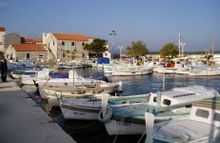Betina
| Betina | |
|---|---|
| Village | |
 | |
 Betina | |
| Coordinates: 43°49′22″N 15°36′17″E / 43.822793°N 15.60465°E | |
| State |
|
| County | Šibenik-Knin County |
| Municipality | Tisno |
| Population (2011) | |
| • Total | 697 |
| Time zone | Central European Time (UTC+1) |
Betina is a village located on the Croatian island of Murter, seven km from Tisno, where a drawbridge connects the island and the mainland. The largest of the Šibenik archipelago islands, and the closest to the mainland, it has been populated since the time of the Illyrians (tribe of Liburns). Remains of the Roman settlement of Colentum as well as many ruins of Roman villas, murals, and mosaic testify to its occupation during the period of the Roman Empire.
History
The island of Murter encompasses 17.9 km² (with nearby islands 25.6 km².) The island was first mentioned by Scardon in memorials of Ptolemy. It was probably first named Srimač in 1251. When King Bela arrived in Dalmatia and in Klobučac near Trogir, he issued a deed of donation which details the borders of Šibenik. The island of Srimač was mentioned as a part of Šibenik.
The Croatian name Srimač was used until 1740, but since 1443, the name Murter is also mentioned (Insula mortari, from the words Mor, sea and tar, tower). In Roman times, there had been a town called Collentum on the island in the area of today's Gradina, which was also mentioned by Ptolemy. A significant colonisation did not occur before the first half of the 16th century, during the Turkish incursion in Ravni Kotari and the Šibenik coast, and Venetian-Turkish conflicts during the second half of the 16th and the first half of the 17th century. Older villages are Murter and Betina, younger ones are Tisno and Jezera. Betina was mentioned for the first time in 1423. at which time the population was 15 persons in 8 houses, which points to an earlier origin of the village. In 1597, there were 16 houses in Betina, and in 1678, 350 persons lived there, belonging to 52 families. Since the middle of the 16th century, Betina has been inhabited by refugees from Vrana, especially since 1573, when Vrana fell under Turkish occupation. The church was built in the 16th Century. On the nearby island of Sustipanac, there was a monastery of the Franciscan friars.
Betina from the sea.
Population
According to the latest census[1] of 2011, there are 697 people living in Betina, 344 of which are male and 353 are female. This is a drop of 77 people since the last census of 2001. 214 people are less than 30 years old, while 212 are older than 60.
Culture and sport
In Betina there is an active folklore and cultural association, "Zora" which preserves the cultural customs of the village. A folklore festival is held every summer. Other associations are the Boccia club "Betina", the men's futsal club "Kalafat", the water polo club "Brodograditelj" and the women's futsal club "Betina"
External links
| Wikimedia Commons has media related to Betina. |
